The Yellow-billed Stork (Mycteria ibis) is a majestic waterbird renowned for its striking appearance and fascinating behaviors.
With its vibrant yellow bill contrasting against a backdrop of predominantly white plumage, this stork commands attention in its wetland habitats across sub-Saharan Africa and parts of Madagascar.
From its communal nesting habits to its piscivorous diet and cooperative breeding behavior, the Yellow-billed Stork captivates bird enthusiasts and researchers with its unique life history.
Join us as we delve into the biography of this iconic avian species, exploring its evolution, habitat preferences, reproductive strategies, conservation status, and cultural significance. Stay sharp.
Pick Out Characteristics of Yellow-billed Stork
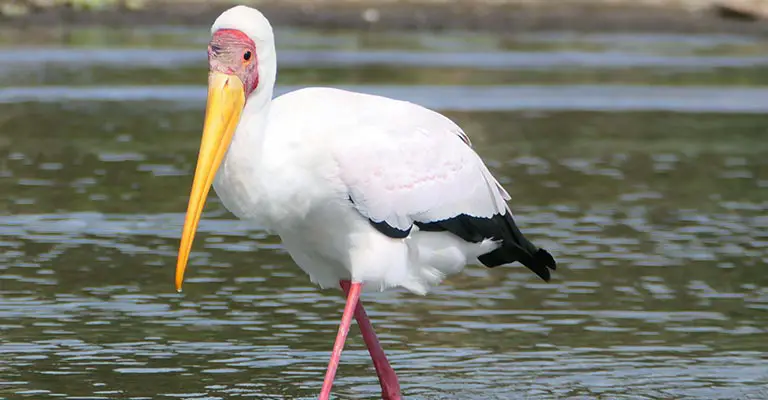
The Yellow-billed Stork (Mycteria ibis) is a striking bird species known for its unique appearance and behavior. Identifying this bird requires attention to several distinct characteristics:
Yellow Bill
As the name suggests, the most prominent feature of the Yellow-billed Stork is its long, thick, and bright yellow bill.
This bill contrasts sharply against the bird’s predominantly white plumage, making it easily recognizable even from a distance.
White Plumage
The Yellow-billed Stork has predominantly white plumage covering its body, with contrasting black flight feathers visible when the bird is in flight. This white coloration extends from its head down to its long legs.
Black Wing Tips
When in flight, the Yellow-billed Stork displays black wingtips against its otherwise white wings. This feature is particularly noticeable and helps differentiate it from other stork species.
Long Legs
Like many stork species, the Yellow-billed Stork has long legs adapted for wading through shallow waters in search of prey. These legs are pinkish and are often visible when the bird is standing or walking.
Large Size
Yellow-billed Storks are large birds, with adults typically reaching around 90 to 105 centimeters (35 to 41 inches). Their wingspan can extend up to 150 centimeters (59 inches), making them an impressive sight when in flight.
Distinctive Silhouette
When seen from a distance or in flight, the Yellow-billed Stork has a distinctive silhouette characterized by its long neck, large bill, and rounded wings.
This silhouette helps birdwatchers quickly identify the species, especially in areas where storks are common.
Habitat Preference
Yellow-billed Storks are primarily found in wetland habitats such as marshes, swamps, and shallow lakes or rivers.
They are often seen foraging in the water, using their specialized bill to catch fish, frogs, crustaceans, and other aquatic prey.
Behavioral Traits
Observing the behavior of the bird can also aid in identification. Yellow-billed Storks are typically seen foraging alone or in small groups, using a slow and deliberate stalking motion to catch prey.
They may also be observed nesting in colonies, often alongside other waterbird species.
Identifying the Yellow-billed Stork involves recognizing its distinct yellow bill, white plumage with black wingtips, long legs, large size, and preferred habitat.
Paying attention to these critical characteristics and observing its behavior can help birdwatchers and enthusiasts confidently identify this beautiful and fascinating bird species in the wild.
Taxonomy of Yellow-billed Stork
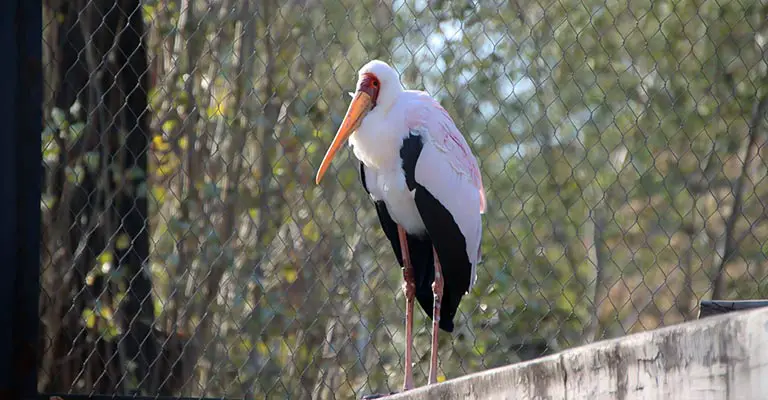
Here’s an informative table detailing the taxonomy of the Yellow-billed Stork:
| Domain | Eukaryota |
| Kingdom | Animalia |
| Phylum | Chordata |
| Class | Aves |
| Clade | Aequornithes |
| Order | Ciconiiformes (Bonaparte, 1854) |
| Family | Ciconiidae |
| Genus | Mycteria |
| Species | M. ibis |
The Yellow-billed Stork (Mycteria ibis) belongs to the family Ciconiidae within the order Ciconiiformes.
Ciconiidae is a diverse family of large, long-legged birds commonly known as storks, comprising 19 genera and around 30 species worldwide.
The Yellow-billed Stork is one of three species within the genus Mycteria, alongside the Milky Stork (Mycteria cinerea) and the Painted Stork (Mycteria leucocephala).
Taxonomically, it is classified as follows: Kingdom: Animalia; Phylum: Chordata; Class: Aves; Order: Ciconiiformes; Family: Ciconiidae; Genus: Mycteria; Species: Mycteria ibis.
This classification reflects its evolutionary relationships and shared characteristics with other stork species while highlighting its distinctiveness as a species within the broader avian diversity.
Reproduction of Yellow-billed Stork
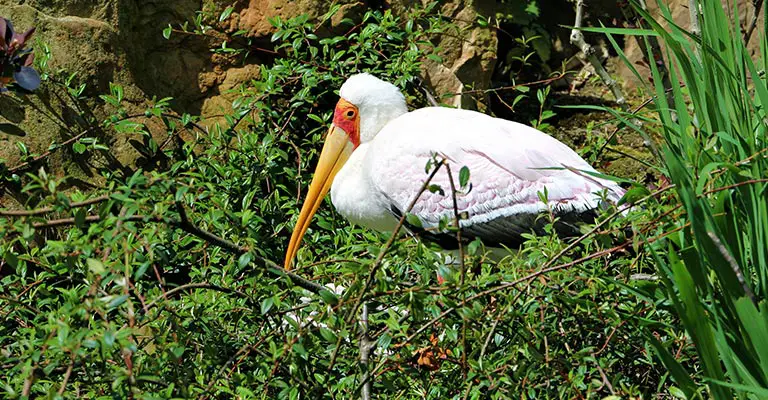
The Yellow-billed Stork engages in a fascinating reproductive process characterized by communal nesting and cooperative breeding.
Breeding typically occurs during the dry season when water levels in wetlands are lower, exposing suitable nesting sites.
These storks build large stick nests in trees or reed beds, often in colonies alongside other waterbird species for protection against predators.
Mating pairs engage in elaborate courtship displays, including bill-clattering and aerial displays, to strengthen their bond.
The female lays a clutch of usually 2-5 eggs, which both parents take turns incubating for about a month. Once hatched, both parents participate in feeding the chicks regurgitated food.
Cooperative breeding behavior is expected, with non-breeding adults assisting in chick rearing. This collaborative effort enhances the survival chances of the chicks, ensuring the continued success of the Yellow-billed Stork population.
Yellow-billed Stork Life History
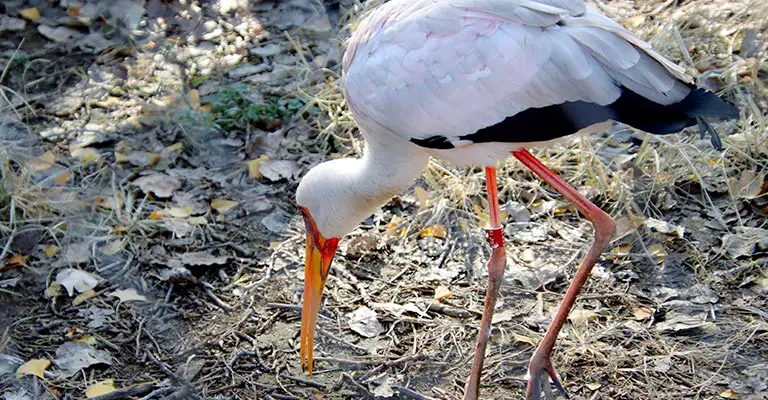
The Yellow-billed Stork (Mycteria ibis) is a remarkable bird species with a rich life history that spans various aspects of its ecology, behavior, and conservation status.
Understanding its life history provides valuable insights into the challenges and adaptations of this iconic waterbird.
Food
Yellow-billed Storks are primarily piscivorous, feeding on fish, crustaceans, amphibians, and other aquatic prey.
Their long, specialized bills enable them to efficiently capture prey in shallow waters, utilizing a slow stalking technique to ambush unsuspecting prey.
They are also known to forage in agricultural fields and wet grasslands for insects and small mammals.
Habitat
These storks inhabit various wetland habitats, including marshes, swamps, rivers, lakes, and estuaries. They prefer shallow, freshwater, or brackish environments with abundant prey availability.
Wetlands provide essential feeding and nesting grounds for the Yellow-billed Stork, making them highly dependent on the conservation of these ecosystems.
Range Map

The Yellow-billed Stork is native to sub-Saharan Africa and parts of Madagascar.
Its range extends from Senegal and Mauritania in the west, across the continent to Ethiopia, Kenya, and Tanzania in the east, and southward to South Africa and Namibia.
Nesting
During the breeding season, Yellow-billed Storks construct large stick nests in trees, reed beds, or sometimes on artificial structures.
They often nest in colonies, forming bustling communities with other waterbird species. Courtship displays involve elaborate behaviors such as bill-clattering and aerial acrobatics, strengthening pair bonds.
A table detailing the nesting details of the Yellow-billed Stork is mentioned below:
| Nesting Details | Facts |
| Clutch Size | 2-5 eggs |
| Number of Broods | Smooth, glossy surface; typically pale bluish-green with irregular brownish markings |
| Egg Length | Approximately 7.5 to 8.5 centimeters (3-3.4 inches) |
| Egg Width | Approximately 4.5 to 5.5 centimeters (1.8-2.2 inches) |
| Incubation Period | Around 28-32 days |
| Nestling Period | Approximately 60-70 days |
| Egg Description | Both parents participate in feeding the chicks regurgitated food; cooperative breeding behavior observed with non-breeding adults assisting in chick rearing. |
| Nest Construction | Large stick nests constructed in trees, reed beds, or on artificial structures |
| Nest Site Selection | Often in colonies alongside other waterbird species for protection |
| Incubation Behavior | Both parents share incubation duties, taking turns to keep the eggs warm |
| Chick Rearing | Both parents participate in feeding the chicks regurgitated food; cooperative breeding behavior was observed with non-breeding adults assisting in chick rearing. |
This table provides a concise overview of the nesting habits and characteristics of the Yellow-billed Stork, including information about clutch size, egg dimensions, incubation, and nestling periods, as well as details about egg appearance, nest construction, and parental behavior during the nesting period.
Diseases and Treatment
Like many wildlife species, Yellow-billed Storks are susceptible to various diseases and health threats. Avian botulism, avian influenza, and habitat degradation are significant concerns.
Efforts to mitigate disease risks include monitoring for outbreaks, implementing biosecurity measures, and habitat restoration initiatives.
Conservation
The conservation status of the Yellow-billed Stork varies across its range, with populations facing threats such as habitat loss, pollution, and human disturbance.
Conservation efforts focus on protecting wetland habitats, regulating fishing practices, and raising awareness about preserving biodiversity.
The life history of the Yellow-billed Stork encompasses diverse aspects of its biology, ecology, and conservation.
By understanding and addressing the challenges this species faces, we can work towards ensuring its continued survival and the preservation of its wetland habitats for future generations.
10 Fun Facts About Yellow-billed Stork
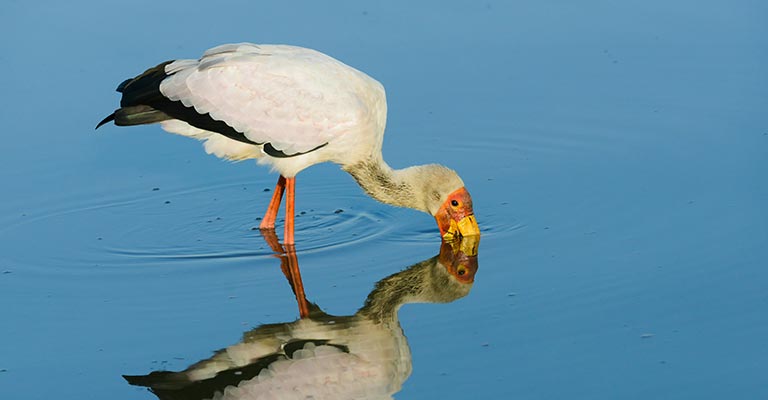
The Yellow-billed Stork (Mycteria ibis) is a captivating bird species with many intriguing characteristics and behaviors. Here are 10 fun facts about these elegant waterbirds:
- Vibrant Bill: The Yellow-billed Stork gets its name from its striking bright yellow bill, which contrasts beautifully against its predominantly white plumage.
- Size Matters: These storks are among the largest of their kind, with adults reaching heights of around 90 to 105 centimeters (35 to 41 inches) and sporting an impressive wingspan of up to 150 centimeters (59 inches).
- Communal Nesters: Yellow-billed Storks often nest in colonies alongside other waterbird species, forming bustling communities where they can benefit from increased protection against predators.
- Aerial Acrobatics: During the breeding season, mating pairs engage in elaborate courtship displays, including spectacular aerial acrobatics and bill-clattering, to strengthen their bond.
- Piscivorous Predators: These storks are primarily piscivorous, meaning they feed predominantly on fish. Their long, specialized bills enable them to catch fish in shallow waters efficiently.
- Global Range: While native to sub-Saharan Africa and parts of Madagascar, Yellow-billed Storks have been spotted as vagrants in other regions, including the Middle East and Europe.
- Migratory Patterns: Although primarily sedentary, some populations of Yellow-billed Storks undertake seasonal migrations in search of suitable feeding and nesting grounds.
- Cooperative Breeders: Cooperative breeding behavior is typical among Yellow-billed Storks, with non-breeding adults assisting in chick rearing to enhance the survival chances of the young.
- Diverse Diet: While fish make up the majority of their diet, Yellow-billed Storks are opportunistic feeders and will also consume crustaceans, amphibians, insects, and even small mammals.
- Conservation Concerns: Like many wetland-dependent species, Yellow-billed Storks face threats from habitat loss, pollution, and human disturbance, making conservation efforts crucial for their long-term survival.
These fun facts shed light on the fascinating world of the Yellow-billed Stork, highlighting its unique traits and the importance of conserving its wetland habitats.
Wrapping Up
The Yellow-billed Stork is a remarkable bird species with a captivating life history.
From its vibrant appearance and communal nesting habits to its diverse diet and conservation challenges, this iconic waterbird fascinates birdwatchers and conservationists alike.
By understanding and appreciating the unique characteristics and behaviors of the Yellow-billed Stork, we can work towards ensuring its continued survival and the preservation of its wetland habitats for future generations to enjoy. Thank you very much.